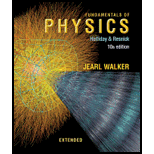
Fundamentals of Physics Extended
10th Edition
ISBN: 9781118230725
Author: David Halliday, Robert Resnick, Jearl Walker
Publisher: Wiley, John & Sons, Incorporated
expand_more
expand_more
format_list_bulleted
Textbook Question
Chapter 14, Problem 67P
ILW In Fig. 14-51, the fresh water behind a reservoir dam has depth D = 15 m. A horizontal pipe 4.0 cm in diameter passes through the dam at depth d = 6.0 m. A plug secures the pipe opening. (a) Find the magnitude of the frictional force between plug and pipe wall. (b) The plug is removed. What water volume exits the pipe in 3.0 h?
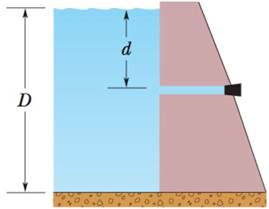
Figure 14-51 Problem 67
Expert Solution & Answer
Trending nowThis is a popular solution!

Chapter 14 Solutions
Fundamentals of Physics Extended
Ch. 14 - We fully submerge an irregular 3 kg lump of...Ch. 14 - Figure 14-21 shows four situations in which a red...Ch. 14 - A boat with an anchor on board floats in a...Ch. 14 - Figure 14-22 shows a tank filled with water. Five...Ch. 14 - The teapot effect. Water poured slowly from a...Ch. 14 - Figure 14-24 shows three identical open-top...Ch. 14 - Figure 14-25 shows four arrangements of pipes...Ch. 14 - A rectangular block is pushed face-down into three...Ch. 14 - Water flows smoothly in a horizontal pipe. Figure...Ch. 14 - We have three containers with different Liquids....
Ch. 14 - ILW A fish maintains its depth in fresh water by...Ch. 14 - A partially evacuated airtight container has a...Ch. 14 - SSM Find the pressure increase in the fluid in a...Ch. 14 - Three liquids that will not mix are poured into a...Ch. 14 - SSM An office window has dimensions 3.4 m by 2.1...Ch. 14 - Prob. 6PCh. 14 - In 1654 Otto von Guericke, inventor of the air...Ch. 14 - The bends during flight. Anyone who scuba dives is...Ch. 14 - Blood pressure in Argentinosaurus. a If this...Ch. 14 - The plastic tube in Fig. 14-30 has a...Ch. 14 - Giraffe bending to drink. In a giraffe with its...Ch. 14 - The maximum depth dmax that a diver can snorkel is...Ch. 14 - At a depth of 10.5 km, the Challenger Deep in the...Ch. 14 - Calculate the hydrostatic difference in blood...Ch. 14 - What gauge pressure must a machine produce in...Ch. 14 - Snorkeling by humans and elephants. When a person...Ch. 14 - SSM Crew members attempt to escape from a damaged...Ch. 14 - In Fig. 14-32, an open tube of length L = 1.8 m...Ch. 14 - GO A large aquarium of height 5.00 m is filled...Ch. 14 - The L-shaped fish tank shown in Fig. 14-33 is...Ch. 14 - SSM Two identical cylindrical vessels with their...Ch. 14 - Prob. 22PCh. 14 - GO In analyzing certain geological features, it is...Ch. 14 - GO In Fig. 14-35, water stands at depth D = 35.0 m...Ch. 14 - In one observation, the column in a mercury...Ch. 14 - To suck lemonade of density 1000 kg/m3 up a straw...Ch. 14 - SSM What would be the height of the atmosphere if...Ch. 14 - A piston of cross-sectional area a is used in a...Ch. 14 - In Fig 14-37, a spring of spring constant 3.00 ...Ch. 14 - A 5.00 kg object is released from rest while fully...Ch. 14 - SSM A block of wood floats in fresh water with...Ch. 14 - In Fig. 14-38, a cube of edge length L = 0.600 m...Ch. 14 - SSM An iron anchor of density 7870kg/m3 appears...Ch. 14 - A boat floating in fresh water displaces water...Ch. 14 - Three children, each of weight 356 N, make a log...Ch. 14 - GO In Fig. 14-39a, a rectangular block is...Ch. 14 - ILW A hollow spherical iron shell floats almost...Ch. 14 - GO A small solid ball is released from rest while...Ch. 14 - SSM WWW A hollow sphere of inner radius 8.0 cm and...Ch. 14 - Lurking alligators. An alligator waits for prey by...Ch. 14 - What fraction of the volume of an iceberg density...Ch. 14 - A Flotation device is in the shape of a right...Ch. 14 - When researchers find a reasonably complete fossil...Ch. 14 - A wood block mass 3.67 kg, density 600 kg/m3 is...Ch. 14 - GO An iron casting containing a number of cavities...Ch. 14 - GO Suppose that you release a small ball from rest...Ch. 14 - The volume of air space in the passenger...Ch. 14 - GO Figure 14-44 shows an iron ball suspended by...Ch. 14 - Canal effect. Figure 14-45 shows an anchored barge...Ch. 14 - Figure 14-46 shows two sections of an old pipe...Ch. 14 - SSM A garden hose with an internal diameter of 1.9...Ch. 14 - Two streams merge to form a river. One stream has...Ch. 14 - SSM Water is pumped steadily out of a flooded...Ch. 14 - GO The water flowing through a 1.9 cm inside...Ch. 14 - How much work is done by pressure in forcing 1.4...Ch. 14 - Suppose that two tanks, 1 and 2, each with a large...Ch. 14 - SSM A cylindrical tank with a large diameter is...Ch. 14 - The intake in Fig. 14-47 has cross-sectional area...Ch. 14 - SSM Water is moving with a speed of 5.0 m/s...Ch. 14 - Models of torpedoes are sometimes tested in a...Ch. 14 - ILW A water pipe having a 2.5 cm inside diameter...Ch. 14 - A pitot tube Fig. 14-48 is used to determine the...Ch. 14 - Prob. 63PCh. 14 - GO In Fig. 14-49, water flows through a horizontal...Ch. 14 - SSM WWW A venturi meter is used to measure the...Ch. 14 - Consider the venturi tube of Problem 65 and Fig....Ch. 14 - ILW In Fig. 14-51, the fresh water behind a...Ch. 14 - GO Fresh water flows horizontally from pipe...Ch. 14 - A liquid of density 900 kg/m3 flows through a...Ch. 14 - GO In Fig. 14-53, water flows steadily from the...Ch. 14 - Figure 14-54 shows a stream of water flowing...Ch. 14 - GO A very simplified schematic of the rain...Ch. 14 - About one-third of the body of a person floating...Ch. 14 - A simple open U-tube contains mercury. When 11.2...Ch. 14 - If a bubble in sparkling water accelerates upward...Ch. 14 - Suppose that your body has a uniform density of...Ch. 14 - Prob. 77PCh. 14 - Caught in an avalanche, a skier is fully submerged...Ch. 14 - An object hangs from a spring balance. The balance...Ch. 14 - In an experiment, a rectangular block with height...Ch. 14 - SSM Figure 14-30 shows a modified U-tube: the...Ch. 14 - What is the acceleration of a rising hot-air...Ch. 14 - Figure 14-56 shows a siphon, which is a device for...Ch. 14 - When you cough, you expel air at high speed...Ch. 14 - A tin can has a total volume of 1200 cm3 and a...Ch. 14 - The tension in a string holding a solid block...Ch. 14 - What is the minimum area in square meters of the...Ch. 14 - A 8.60 kg sphere of radius 6.22 cm is at a depth...Ch. 14 - a For seawater of density 1.03 g/cm3, find the...Ch. 14 - The sewage outlet of a house constructed on a...
Additional Science Textbook Solutions
Find more solutions based on key concepts
30 (Il) Calculate the electric field at the center of a square 42.5 cm on a side if one corner is occupied by a...
Physics: Principles with Applications
We know that warm air rises. So it might seem that the air temperature should be higher at the top of mountains...
Conceptual Physics: The High School Physics Program
The Genetic Code. Suppose that, as evidence suggests, very early life on Earth used a genetic code that consist...
Life in the Universe (4th Edition)
A torque of 5.00103Nm is required to raise a drawbridge (see the following figure). What is the tension necessa...
University Physics Volume 1
Can a single microwave photon cause cell damage? Explain.
College Physics
Knowledge Booster
Learn more about
Need a deep-dive on the concept behind this application? Look no further. Learn more about this topic, physics and related others by exploring similar questions and additional content below.Similar questions
- A garden hose with a diameter of 2.0 cm is used to fill a bucket, which has a volume of 0.10 cubic meters. It takes 1.2 minutes to fill. An adjustable nozzle is attached to the hose to decrease the diameter of the opening, which increases the speed of the water. The hose is held level to the ground at a height of 1.0 meters and the diameter is decreased until a flower bed 3.0 meters away is reached. (a) What is the volume flow rate of the through the nozzle when the diameter 2.0 cm? (b) What does is the speed of coming out of the hose? (c) What does the speed of the water coming out of the hose need to be to reach the flower bed 3.0 meters away? (d) What is be diameter of nozzle needed to reach be flower bed?arrow_forwardAn ideal fluid flows through a horizontal pipe whose diameter varies along its length. Measurements would indicate that the sum of the kinetic energy per unit volume and pressure at different sections of the pipe would (a) decrease as the pipe diameter increases, (b) increase as the pipe diameter increases, (c) increase as the pipe diameter decreases, (d) decrease as the pipe diameter decreases, or (e) remain the same as the pipe diameter changes.arrow_forwardThe gravitational force exerted on a solid object is 5.00 N. When the object is suspended from a spring scale and submerged in water, the scale reads 3.50 N (Fig. P15.24). Find the density of the object. Figure P15.24 Problems 24 and 25.arrow_forward
- Water enters a smooth, horizontal tube with a speed of 2.0 m/s and emerges out of the tube with a speed of 8.0 m/s. Each end of the tube has a different cross-sectional radius. Find the ratio of the entrance radius to the exit radius.arrow_forwardBird bones have air pockets to reduce their weight—this also gives them an average density significantly less than that of the bones of other animals. Suppose an ornithologist weighs a bird bone air and in water and finds its mass is 45.0 g ad its apparent mass when submerged is 3.60 g (assume the bone is watertight.)(a) What mass of is displaced? (b) What is the volume of the bone? (c) What is its average density?arrow_forwardA frequency quoted rule of thumb aircraft design is that wings should produce about 1000 N of lift per square meter of wing. (The fact that a wing has a top and bottom surface does not double its area.) (a) At takeoff, an aircraft travels at 60.0 m/s, so that the air speed relative to the bottom of the wing is 60.0 m/s. Given be sea level density of air as 1.29kg/m3, how fast must it move over be upper surface to create the ideal lift? (b) How fast must air move over the upper surface at a cruising speed of 245 m/s and at an altitude where air density is one-fourth that at sea level? (Note that his not all of be aircraft's lift—some comes from be body of the plane, some from engine thrust, and so on. Furthermore, Bernoulli's principle gives approximate answer because flow over wing creates turbulence.)arrow_forward
- A U-tube open at both ends is partially filled with water (Fig. P15.67a). Oil having a density 750 kg/m3 is then poured into the right arm and forms a column L = 5.00 cm high (Fig. P15.67b). (a) Determine the difference h in the heights of the two liquid surfaces. (b) The right arm is then shielded from any air motion while air is blown across the top of the left arm until the surfaces of the two liquids are at the same height (Fig. P15.67c). Determine the speed of the air being blown across the left arm. Take the density of air as constant at 1.20 kg/m3.arrow_forwardMercury is poured into a U-tube as shown in Figure P15.17a. The left arm of the tube has cross-sectional area A1 of 10.0 cm2, and the right arm has a cross-sectional area A2 of 5.00 cm2. One hundred grams of water are then poured into the right arm as shown in Figure P15.17b. (a) Determine the length of the water column in the right arm of the U-tube. (b) Given that the density of mercury is 13.6 g/cm3, what distance h does the mercury rise in the left arm?arrow_forwardReview. The lank in Figure P14.15 is filled with water of depth d = 2.00 m. At the bottom of one sidewall is a rectangular hatch of height h = 1.00 m and width w = 2.00 in that is hinged at the top of the hatch, (a) Determine the magnitude of the force the water exerts on the hatch, (b) Find the magnitude of the torque exerted by the water about the hinges.arrow_forward
- How many cubic meters of helium are required to lift a balloon with a 400-kg payload to a height of 8 000 m? Take He = 0.179 kg/m3. Assume the balloon maintains a constant volume and the density of air decreases with the altitude z according to the expression air = 0ez/8, where z is in meters and 0 = 1.20 kg/m3 is the density of air at sea level.arrow_forwardIn about 1657, Otto von Guericke, inventor of the air pump, evacuated a sphere made of two brass hemispheres (Fig. P15.62). Two teams of eight horses each could pull the hemispheres apart only on some trials and then with greatest difficulty, with the resulting sound likened to a cannon firing. Find the force F required to pull the thin-walled evacuated hemispheres apart in terms of R, the radius of the hemispheres; P, the pressure inside the hemispheres; and atmospheric pressure P0. Figure P15.62arrow_forward
arrow_back_ios
arrow_forward_ios
Recommended textbooks for you
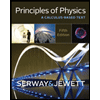 Principles of Physics: A Calculus-Based TextPhysicsISBN:9781133104261Author:Raymond A. Serway, John W. JewettPublisher:Cengage Learning
Principles of Physics: A Calculus-Based TextPhysicsISBN:9781133104261Author:Raymond A. Serway, John W. JewettPublisher:Cengage Learning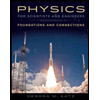 Physics for Scientists and Engineers: Foundations...PhysicsISBN:9781133939146Author:Katz, Debora M.Publisher:Cengage Learning
Physics for Scientists and Engineers: Foundations...PhysicsISBN:9781133939146Author:Katz, Debora M.Publisher:Cengage Learning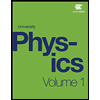 University Physics Volume 1PhysicsISBN:9781938168277Author:William Moebs, Samuel J. Ling, Jeff SannyPublisher:OpenStax - Rice University
University Physics Volume 1PhysicsISBN:9781938168277Author:William Moebs, Samuel J. Ling, Jeff SannyPublisher:OpenStax - Rice University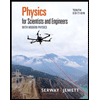 Physics for Scientists and Engineers with Modern ...PhysicsISBN:9781337553292Author:Raymond A. Serway, John W. JewettPublisher:Cengage Learning
Physics for Scientists and Engineers with Modern ...PhysicsISBN:9781337553292Author:Raymond A. Serway, John W. JewettPublisher:Cengage Learning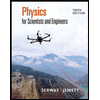 Physics for Scientists and EngineersPhysicsISBN:9781337553278Author:Raymond A. Serway, John W. JewettPublisher:Cengage Learning
Physics for Scientists and EngineersPhysicsISBN:9781337553278Author:Raymond A. Serway, John W. JewettPublisher:Cengage Learning Physics for Scientists and Engineers, Technology ...PhysicsISBN:9781305116399Author:Raymond A. Serway, John W. JewettPublisher:Cengage Learning
Physics for Scientists and Engineers, Technology ...PhysicsISBN:9781305116399Author:Raymond A. Serway, John W. JewettPublisher:Cengage Learning

Principles of Physics: A Calculus-Based Text
Physics
ISBN:9781133104261
Author:Raymond A. Serway, John W. Jewett
Publisher:Cengage Learning

Physics for Scientists and Engineers: Foundations...
Physics
ISBN:9781133939146
Author:Katz, Debora M.
Publisher:Cengage Learning

University Physics Volume 1
Physics
ISBN:9781938168277
Author:William Moebs, Samuel J. Ling, Jeff Sanny
Publisher:OpenStax - Rice University

Physics for Scientists and Engineers with Modern ...
Physics
ISBN:9781337553292
Author:Raymond A. Serway, John W. Jewett
Publisher:Cengage Learning

Physics for Scientists and Engineers
Physics
ISBN:9781337553278
Author:Raymond A. Serway, John W. Jewett
Publisher:Cengage Learning

Physics for Scientists and Engineers, Technology ...
Physics
ISBN:9781305116399
Author:Raymond A. Serway, John W. Jewett
Publisher:Cengage Learning
How to Calculate Density of Liquids - With Examples; Author: cleanairfilms;https://www.youtube.com/watch?v=DVQMWihs3wQ;License: Standard YouTube License, CC-BY